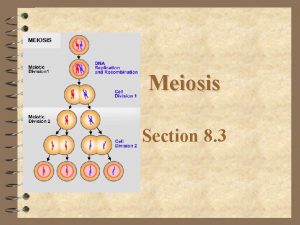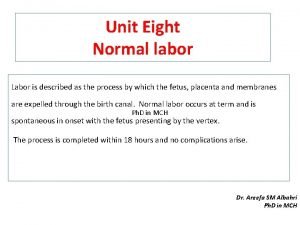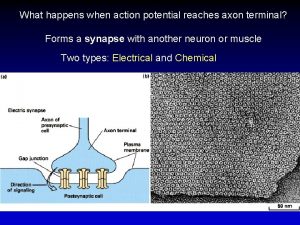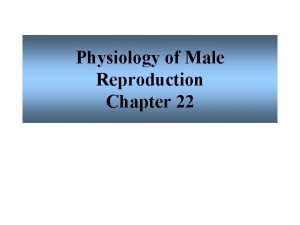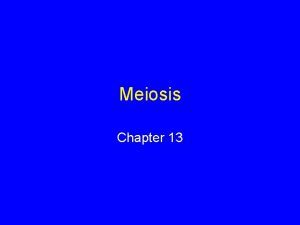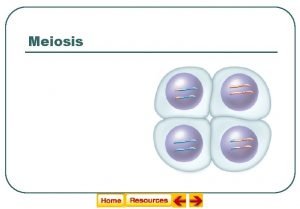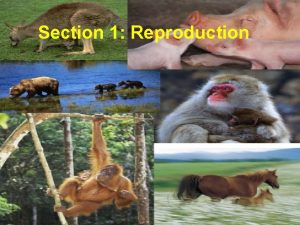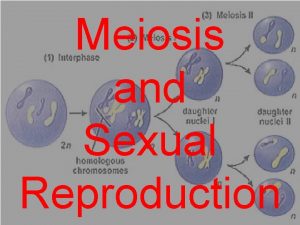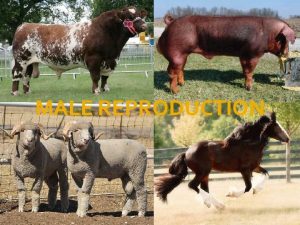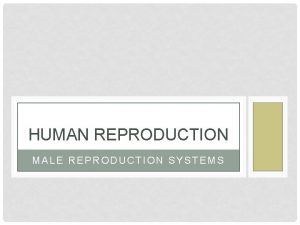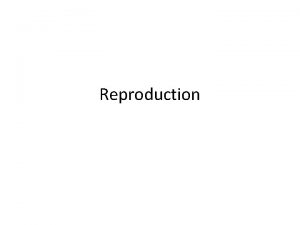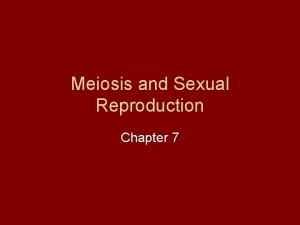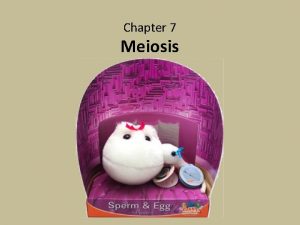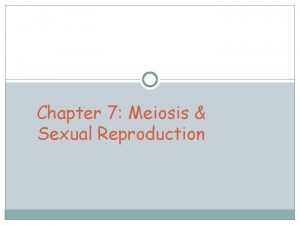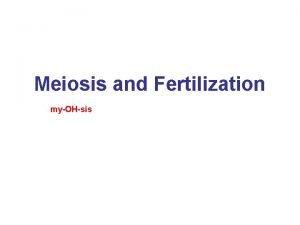Chapter 9 Meiosis A Reproduction 1 Male reaches

















- Slides: 17

Chapter 9 Meiosis A. Reproduction 1. ____ Male reaches under his mantle with tentacle, removes packet of sperm, and insert it into female’s egg chamber 2. _______ Larva can become adult of either sex –Depends on conditions 3. _____ • Females in summer (from unfertilized eggs) • Males in autumn

_______Reproduction • Single _____ produces offspring • All offspring are _________ to one another and to parent ____ Reproduction • Two parents contribute to offspring • All offspring are ________

Terminology ______ Chromosomes Carry Different ______ • Cell has two of each__________ • One from mother, other from father • Paternal and maternal chromosomes carry different ____ • Offspring inherit new combinations of alleles • This variation in traits is the basis for _________change

Gamete Formation • Gametes are ___ cells (_______, ______) • Arise from _____cells ovaries testes anther ovary Chromosome Number • Germ cells are ______ (2 n) • Gametes are ____(n) • Meiosis _____ chromosome number

Meiosis: ____ nuclear divisions, ____ DNA replication _____ PROPHASE I DNA replication METAPHASE I _____ No DNA _____ PROPHASE II METAPHASE II ANAPHASE II TELOPHASE II 4 ______ nuclei

Meiosis I and II very similar to mitosis 1. DNA exchange occurs in ____ - Homologues swap _____ Each homologue in the cell pairs with its partner, then the partners separate PROPHASE I METAPHASE I ANAPHASE I TELOPHASE I 2. No ________ prior to Meiosis II

Crossing Over These exchange points are called ______ • ________ chromosomes exchange segments • Creates new allele _______ in offspring

Meiosis II - Stages Prophase II Metaphase II Anaphase II Telophase II

Comparison of mitosis and meiosis Meiosis End result Daughter cells Chiasmata? # of divisions Purpose _______ are __________ ____ Mitosis ________ ___ _______ the physical manifestation of crossing over, a form of genetic rearrangement.

MITOSIS PROPHASE METAPHASE ANAPHASE TELOPHASE MEIOSIS II PROPHASE II METAPHASE II ANAPHASE II TELOPHASE II Fig. 9. 10 a p. 148

Possible Chromosome Combinations • number of possible combinations of chromosomes in a gamete is: • ____ (n is number of chromosome types) 1 or or or 2 3

Factors Contributing to Variation Among Offspring 1. Crossing over during _____ 2. Random _____ of chromosomes at metaphase I 3. Random combination of ______at fertilization

Plant Life Cycle mitosis multicelled sporophyte zygote fertilization Diploid meiosis Haploid spores gametes multicelled gametophytes mitosis

Animal Life Cycle mitosis multicelled body zygote fertilization Diploid Haploid gametes meiosis

Spermatogenesis secondary spermatocytes (haploid) spermatogonium (diploid male reproductive cell) primary spermatocyte (diploid) Growth Mitosis I, Cytoplasmic division spermatids (haploid) Meiosis II, Cytoplasmic division

Oogenesis first polar body haploid) oogonium (diploid reproductive cell) Growth three polar bodies haploid) primary oocyte (diploid) secondary oocyte haploid) Mitosis I, Cytoplasmic division ovum (haploid) Meiosis II, Cytoplasmic division

Fertilization • Male and female ______ unite and nuclei _____ • Fusion of two haploid nuclei produces _______ nucleus in the zygote • Which two gametes unite is _______ – Adds to variation among offspring
 When does crossing over occur during meiosis?
When does crossing over occur during meiosis? Chapter 10 section 1 meiosis worksheet answer key
Chapter 10 section 1 meiosis worksheet answer key Chapter 10 section 10.2 meiosis worksheet answer key
Chapter 10 section 10.2 meiosis worksheet answer key Asexual reproduction cell division
Asexual reproduction cell division Hare lynx
Hare lynx Asexual vs sexual venn diagram
Asexual vs sexual venn diagram Sexual reproduction and genetics section 1 meiosis
Sexual reproduction and genetics section 1 meiosis Chapter 10 section 3 gene linkage and polyploidy
Chapter 10 section 3 gene linkage and polyploidy Section 8-3 meiosis
Section 8-3 meiosis Anaphase
Anaphase Meisis 1 and 2
Meisis 1 and 2 Difference between meiosis 1 and meiosis 2
Difference between meiosis 1 and meiosis 2 Picture of prophase 2
Picture of prophase 2 True labour contractions
True labour contractions Refraction
Refraction What happens when action potential reaches axon terminal
What happens when action potential reaches axon terminal Food adulteration reaches new height
Food adulteration reaches new height Refraction of light
Refraction of light








